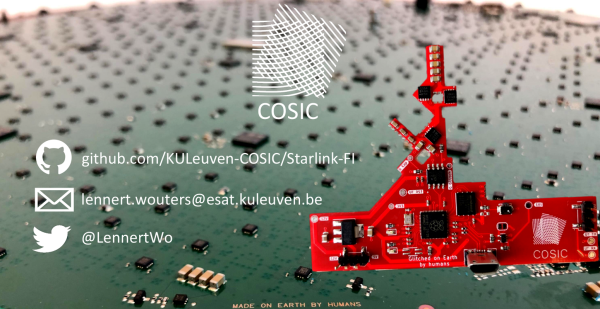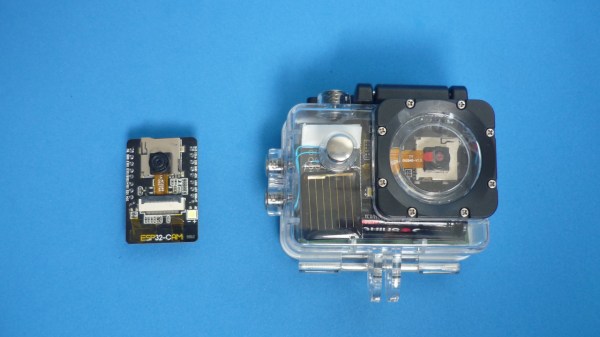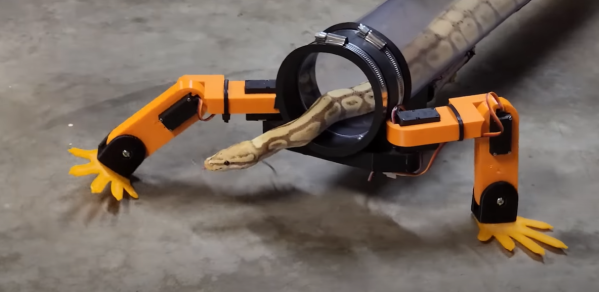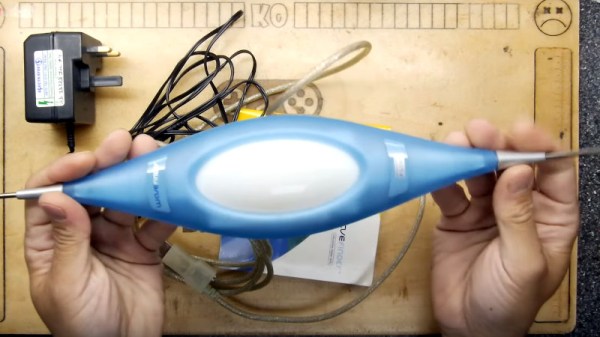What’s this? News about robot dogs comes out, and there’s no video of the bots busting a move on the dance floor? Nope — it looks like quadruped robots are finally going to work for real as “ground drones” are being deployed to patrol Cape Canaveral. Rather than the familiar and friendly Boston Dynamics “Big Dog” robot, the US Space Force went with Ghost Robotics Vision 60 Q-UGVs, or “quadruped unmanned ground vehicles.” The bots share the same basic layout as Big Dog but have a decidedly more robust appearance, and are somehow more sinister. The dogs are IP67-rated for all-weather use, and will be deployed for “damage assessments and patrols,” whatever that means. Although since this is the same dog that has had a gun mounted to it, we’d be careful not to stray too far from the tours at Kennedy Space Center.
Starlink Ground Stations Successfully Hacked
Belgian security researcher [Lennert Wouters] has gotten his own code running on the Starlink “Dishy McFlatface” satellite terminals, and you can too! The hack in question is a “modchip” with an RP2040 and a MOSFET that crowbars the power rails, browning out the main CPU exactly when it’s verifying the firmware’s validity and bypassing that protection entirely. [Lennert] had previously figured out how to dump the Starlink firmware straight from the eMMC, and with the ability to upload it back, the circle of pwnership is closed. This was a talk at DEFCON, and you can check out the slides here. (PDF)
The mod chip itself was a sweet piece of work, being tailored to fit into the Starlink’s motherboard just so, and taking good advantage of the RP2040’s PIOs, which are probably the microcontroller’s superpower.
[Lennert] says he submitted his glitch attack to Starlink and they took some precautions to make the glitching harder. In particular, [Lennert] was triggering his timing off of the USART port coming up on the Starlink unit, so Starlink just shut that down. But it’s not like he couldn’t trigger on some other timing-relevant digital signal, so he chose the eMMC’s D0 data line: they’re not going to be able to boot up without it, so this hack is probably final. No shade against Starlink here. It’s almost impossible to shield a device against an attacker who has it on their bench, and [Lennert] concludes that he found no low-hanging fruit and was impressed that he had to work so hard to get root.
What can you do with this? Not much, yet. But in principle, it could be used to explore the security of the rest of the Starlink network. As reported in Wired, Starlink says that they’ve got a defence-in-depth system and that just getting into the network doesn’t really get you very far. We’ll see!
Thanks [jef] for the tip!
Hackaday Prize 2022: Solar-Harvesting ESP32 Camera Is Waterproof, Repeatable
[alberto nunez] shows off his sleek build of a solar-harvesting ESP32 camera – waterproof, somewhat energy-efficient, and able to be built by more-or-less anyone. For that, he’s chosen fairly jellybean components – an ESP32-CAM module with a matching protoboard, a small solar cell, a LiFePO4 battery, and a waterproofed GoPro shell that all of these parts neatly fit into.
A BQ25504 energy harvesting chip is used to ensure the ‘solar’ part of the project can meaningfully contribute to the project’s power budget, with energy otherwise mainly provided by the LiFePo4 battery. Since this battery’s nominal voltage is 3.2 V, it can be wired straight to ESP32’s power input and there’s no need for a regulator – thus, that one got mercilessly desoldered. [alberto] has also modded the board using a FET to gate power to the ESP32-CAM module’s camera, with all of these hacks bringing the board’s deep sleep current from 2.8 mA to 0.8 mA. Not great for a low-power device, but not terrible for something you can build so easily. Plus, it’s waterproof, dust-resistant, and quite robust!
These ESP32 camera modules are seriously nifty – we see them put to good use on the regular. Whether you need to detect motion in your Halloween project, decode your water meter readings, or perhaps merely a security camera, it’s worth having a few in your toolbox. Maybe even pick up a programming helper for these while you’re at it!
This Snake Has Legs
[Allen Pan] loves snakes. He loves them so much that he’s decided to play god, throwing away millions of years of evolution — just to give snakes back the legs they’ve “lost”.
Ok, so this hack has tongue planted firmly in cheek, but it’s still pretty darn cool. [Allen] designed and 3D printed what can best be described as a robot for snakes to ride.
The build wasn’t easy. Allen’s first attempts using toys based on [Jamie Mantzel]’s giant robot didn’t go exactly to plan. Thankfully those were only tested with a plush snake test dummy. Thankfully [Allen’s] second was on target.
The robot itself consists of 4 legs, each with 3 joints and two servos. The foot joint pivots freely to handle any uneven terrain. The robot’s gait is derived from lizards Allen observed in a pet shop. The main body of the robot is a clear plastic tube. Once Shinji the snake decides to get in the robot, it isn’t strapped in. In fact, the snake is free to leave whenever it wants.
Currently, the whole system just walks forward. [Allen] appears to be using a servo controller with a hard-coded walking sequence. We’d love to see the next step – figuring out a way for the snake to control the robot’s direction. Perhaps with a camera with gaze detection?
We’ve covered robots driven by animals before, and we’ve covered some of [Allen]’s builds — like this electromagnetic rendition on Mjölnir.
Continue reading “This Snake Has Legs”
Hoverboard Go-Kart Build Is A Delight To Watch
Hoverboards have been an indispensable material for hackers building their own vehicles in the last few years. [Mahmut Demir] shows how he’s built a hoverboard-powered go-kart for his son. Unable to hack the board’s firmware, he instead set out to reuse the hoverboard without any disassembly, integrating it into the go-kart’s frame as-is. This build is completely mechanical, distinguished in its simplicity – and the accompanying six minute video shows it all.
This go-kart’s frame is wood and quite well-built, with the kind of personal touch that one would expect from a father-son gift. Building the vehicle’s nose out of a trashcan gave us a chuckle and earned bonus points for frugality, and the smiley face-shaped wheel is a lovely detail. As for the ‘hoverboard reuse’ part, the board is pivoted backward and forward, just as it normally would be. Rather than feet, the kart uses a lever that’s driven with two pedals through a pulley-string arrangement, giving granular speed control and the ability to reverse. It’s a clever system, in fact we don’t know if we could’ve done it better. You can see [Mahmut]’s son wandering in the background as [Mahmut] goes through the assembly steps — no doubt, having fun doing his own part in the build process.
[Mahmut] tells us he’s also added a remote off switch as a safety feature, and we appreciate that. We’ve seen hoverboards in go-kart builds before, as well as rovers, e-bikes, robot vehicles, and even mobility platforms. Truly, the hoverboard is a unicorn of hacker transportation helpers.
Continue reading “Hoverboard Go-Kart Build Is A Delight To Watch”
Just How Good Is A Tape Measure Antenna Anyway?
Amateur radio operators have played a longstanding game of “Will It Antenna?” If there’s something even marginally conductive and remotely resonant, a ham has probably tried to make an antenna out of it. Some of these expedient antennas actually turn out to be surprisingly effective, but as we can see from this in-depth analysis of the characteristics of tape measure antennas, a lot of that is probably down to luck.
At first glance, tape measure antennas seem to have a lot going for them (just for clarification, most tape measure antennas use only the spring steel blade of a tape measure, not the case or retraction mechanism — although we have seen that done.) Tape measures can be rolled up or folded down for storage, and they’ll spring back out when released to form a stiff, mostly self-supporting structure.
But [fvfilippetti] suspected that tape measures might have some electrical drawbacks, thanks to the skin effect. That’s the tendency for current to flow on the outside of a conductor, which at lower frequencies on conductors with a round cross-section turns out to be not a huge problem. But in a thin, rectangular conductor, a little finite element method magnetics (FEMM) analysis revealed that most of the current is carried in very small areas, resulting in high electrical resistance — an order of magnitude greater than a round conductor. Add in the high permittivity of the carbon steel material of the blade, and you end up something more like what [fvfilippetti] calls “a tape measure dummy load.
One possible solution: stripping the paint off the blade and copper plating it. It’s not clear if this was tried; we’d think it would be difficult to accomplish, but not impossible — and surely worth a try.
Remember DAB Radio? The Psion WaveFinder Gets A Teardown
With digital music making a clean sweep in the 1990s over almost all listening media, it’s a surprise to find that there’s one area in which an analog hold-out is still very much alive and kicking. We’re talking not of a vinyl resurgence here but of FM radio, which has managed to effectively hold off its digital competition for a few decades now. Twenty years ago its days seemed numbered though, and in Europe the first generation of DAB digital radios looked ready to conquer the airwaves. Among them was a true oddity and one of Psion’s last significant consumer products, the WaveFinder USB DAB radio receiver. [Backofficeshow] has one, and has given it a teardown for our entertainment. He describes it as the first consumer SDR product which may be a little hyperbolic, but nevertheless, it’s an interesting look at what would become one of computing’s backwaters.
Inside the peak-90s-style translucent blue case is a single PCB with a lot of screening, on which sits a USB controller and a bunch of DSP chips. Radio demodulation was done in hardware, but signal demodulation was apparently done on the host PC. At the time its £299 price made it the affordable end of DAB reception, and The Register opined that its ability to download broadcast broadband data made it a revolutionary product, but sadly neither consumers nor broadcasters agreed and it was heavily discounted before making an ignominious exit. DAB itself would struggle to meet the expectations, and a multiplex-based licensing model for broadcasters making it unattractive to local stations means that even now FM is still full of stations. Perhaps as listening moves inexorably to streaming its time has passed, indeed Ireland has gone so far as to abandon DAB altogether.
If you’d like to know more about DAB, we took a look at the technology a while back.
Continue reading “Remember DAB Radio? The Psion WaveFinder Gets A Teardown”




















